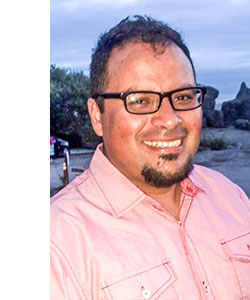Cesar Abarca, Department of Social Work

Where are you originally from?
I was born in Mexico City and raised in Los Angeles and San Francisco. I have lived in Boston, Long Beach, Las Cruces and Albuquerque.
Where did you complete your education?
I earned my BSW and MSW from San Francisco State University and my interdisciplinary doctoral degree in Sociology and Social Welfare form Boston University.
Where have you taught prior to coming to HSU?
I taught three semesters at California State University Long Beach and I taught at New Mexico State University in Las Cruces, N.M., for just one semester.
What are your specific areas of expertise?
My areas of expertise are: employment, immigration (theory, practice and policy), community development and engagement, social movements, and grassroots community organizing.
What classes are you teaching this year?
I am teaching research methods to undergraduate students (live and online) and the Master’s Thesis class to graduate students, which is a two-course sequence. I will be teaching the social work experience to pre-majors as well next semester.
_What attracted you to Humboldt State?+
The natural beauty of the place, the opportunity of serving a growing population of Chicano/Latino students, and the opportunity to impact the next 100 years of HSU.
What do you do in your free time outside the classroom?
I am involved in a community-based organization which is grassroots, multigenerational and centers on economic and environmental justice, Los Jardines Institute (LJI). It is based in Albuquerque, but it servers the whole state. We have three projects: an agricultural project (community gardens development and trainings), a literacy project (including a banned books library and a monthly book club), and a chemical policy and environmental justice project (which includes advocacy for communities of color at the national level and an intergenerational youth exchange during the summer).
What is your favorite classroom technique to engage students?
I like to show films which reflect contemporary social problems and then have critical discussion with my students about how these problems impact the communities where they live, work, study and worship.
What is the best thing about being a university professor?
The big responsibility to expand your students mental and academic horizon. Being an activist-scholar, the first thing to do is to challenge my students’ perspective on history, objective reality and social theory.
Where is the strangest place you’ve done research?
In a public park, 7,000 feet above sea level, with six inches of snow, in 8 degree weather … the least desirable place to be conducting participant observation.
If you weren’t an HSU professor, what would you be?
A radical community organizer fighting environmental, social, economic, political and health racism locally and globally
What superpower would be most valuable to your research?
The ability to have a body part that records interviews and transcribes them for you. An awsome power for an ethnographer.
Sheila Alicea, Department of Kinesiology & Recreation

Where are you originally from?
Novato, Calif.
Where did you complete your education?
B.S., CSU Chico
M.A., CSU Long Beach
Ph.D., Michigan State University
Where have you taught prior to coming to HSU?
California State University Long Beach and Michigan State University, and I was a Lecturer at HSU the past three years
What are your specific areas of expertise?
My specific areas of expertise in Kinesiology are: Psychological and sociological aspects of sport, exercise, and physical activity, and growth and motor development
What classes are you teaching this year?
KINS 640 and KINS 474 Psychology of Sport and Exercise (graduate and undergraduate classes)
KINS 484 Motor Development/Motor Learning
I have also taught a variety of other classes here, such as Sport in Society, Senior Seminar in Kinesiology, Pre-Physical Therapy Practica, Evaluation Techniques in Kinesiology, and others!
What attracted you to Humboldt State?
The small, learning-centered campus and the awesome faculty, staff, and students, and it continues to exceed my expectations!
What do you do in your free time outside the classroom?
Although I have been here for three years, I am still enjoying exploring Humboldt County! I also enjoy spending time with my family and friends, traveling, wakeboarding, snowboarding, exercising (group exercise classes are my favorite), and trying my husband’s culinary concoctions (he’s a Chef).
What is your favorite classroom technique to engage students?
Funny and educational video clips that apply to class material. I am also using clickers for the first time this semester, which has been a great tool so far for both engagement and assessment.
What is the best thing about being a university professor?
The best thing is that every day and every semester is new and different, and I get to see students learn and grow while I continue to teach, research, and learn about a constantly evolving field. And that feeling when students tell me that I, or taking my classes, have made a difference in their lives.
Where is the strangest place you’ve done research?
I haven’t really done research anywhere strange … but conducting research in schools is always interesting!
If you weren’t an HSU professor, what would you be?
I can’t imagine doing anything else … I feel very fortunate to have found a career doing something I love.
What superpower would be most valuable to your research?
Flying so I could travel all over the world to collect data, or freezing time so there were more hours in the day.